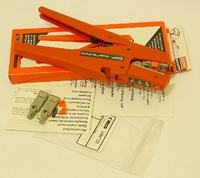There were already such topics, but here I would like to compare several types of these devices.
1. Frontal stripping tool, referred to as "electrotechnical":

2. Side insulation stripper:
http://www.tme.eu/html/PL/narzedzia-do-sciaga...z-pirectow-okraglych/ramka_2465_PL_pelny.html

3. Automatic insulation stripper (with holding the stripped wire):
http://www.tme.eu/html/PL/narzedzia-do-sciaga...plaskich-i-okraglych/ramka_2468_PL_pelny.html

These are the basic types, of course there are a few more. From what I've read, the number 3 is recommended, but I have some concerns about its ability to strip insulation from very short sections of wires (around 1cm) and strip insulation from tapes, where there are many wires next to each other, and I do not want to separate them, for example at a length greater than 7-8mm.
My requirements:
- a maximum price of PLN 50, but much cheaper is welcome (do not be influenced by the prices from TME, these are only illustrative photos)
- cable diameters preferably from 0.2 to 2mm (or 1.5mm).
- the possibility of removing insulation from short sections of wires - here I think the best type 1 or 2
- the possibility of stripping insulation from multi-conductor tapes - e.g. 20 wires - type 1 and 2 allows this, but you need one, how does type 3 deal in such situations?
- I only had type 2 in my hands, it seemed reasonable, but maybe it can be done better
- I do not need a puller + crimper all in one
1. Frontal stripping tool, referred to as "electrotechnical":

2. Side insulation stripper:
http://www.tme.eu/html/PL/narzedzia-do-sciaga...z-pirectow-okraglych/ramka_2465_PL_pelny.html

3. Automatic insulation stripper (with holding the stripped wire):
http://www.tme.eu/html/PL/narzedzia-do-sciaga...plaskich-i-okraglych/ramka_2468_PL_pelny.html

These are the basic types, of course there are a few more. From what I've read, the number 3 is recommended, but I have some concerns about its ability to strip insulation from very short sections of wires (around 1cm) and strip insulation from tapes, where there are many wires next to each other, and I do not want to separate them, for example at a length greater than 7-8mm.
My requirements:
- a maximum price of PLN 50, but much cheaper is welcome (do not be influenced by the prices from TME, these are only illustrative photos)
- cable diameters preferably from 0.2 to 2mm (or 1.5mm).
- the possibility of removing insulation from short sections of wires - here I think the best type 1 or 2
- the possibility of stripping insulation from multi-conductor tapes - e.g. 20 wires - type 1 and 2 allows this, but you need one, how does type 3 deal in such situations?
- I only had type 2 in my hands, it seemed reasonable, but maybe it can be done better
- I do not need a puller + crimper all in one



